Let’s Follow the Footsteps of André Le Nôtre, the Creator of the Groves of Versailles Gardens
I think it was under Louis XIV’s reign that the groves were mainly developed. Some were later transformed under Louis XVI and Louis XVIII. What has become of the 14 original groves imagined by André Le Nôtre, 48 years old at the time?
In 1639, during the reign of Louis XIII, two groves were first arranged in the Versailles gardens. Fourteen were later added by Louis XIV from 1663 to 1686, but soon after many changed appearance. Thus, during the reign of Louis XIV, the Colonnade, the Salle des Marronniers and the Obelisk replaced the Sources, the Salle des Antiques and the Salade des Festins, while the Domes grove, the Enceladus, the Dauphin and the Girandole were modified. Under Louis XVI, six groves were transformed according to the neo-classical fashion of the time. Today, only six groves evoke those originally proposed by Le Nôtre: the Ballroom, the Dauphin, the Girandole, the Encelade, the Domes and the Three Fountains.
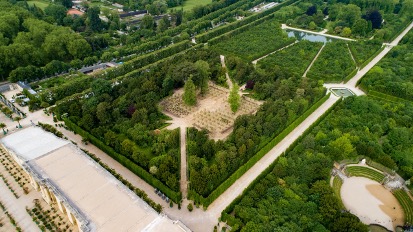
Photo Credit: ©Château de Versailles / T. Garnier
The descendants of Louis XIV transformed the groves according to the trends of the moment. The fashion at the time was the baroque influenced by Italian tastes. The groves, overflowing with water and rocks, were inspired by the Apollonian theme dear to the king. Can you describe two of your favorite groves and why?
The groves at Versailles are as different from Italian themes, which Le Nôtre did not know (there are no equivalent groves in Italy), as they are from the Apollonian style reserved for the fountains along the main axes of the garden. These were original works that could not be blended with pre-existing ones. Two of them were particularly original: the Labyrinth and the Springs. The Labyrinth was a group of fountains illustrating Aesop’s fables with superb animal sculptures, trellises, basins adorned with shells and clever water features. The Grove of Springs was a collection of paths and winding streams winding through an undergrowth. Devoid of geometric basins, fountains, and sculptural decoration, it evoked a bucolic landscape completely different from the neighboring green enclosures. Both works soon disappeared because of their fragility.
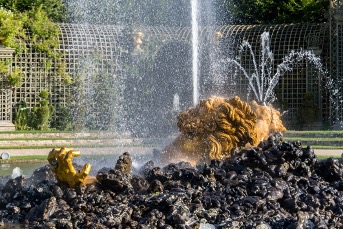
Photo Credit: ©Château de Versailles / T. Garnier
After Colbert’s death, Controller General of Finances of Louis XIV, the architect Jules Hardouin Mansart took over from Le Nôtre. Is there a difference in style with that of Le Nôtre?
Mansart succeeded Le Nôtre little by little because of his age: in 1686, Jules Hardouin-Mansart was forty years old when Le Nôtre was seventy-three. It was Le Nôtre himself who had introduced Mansart to Versailles and, contrary to legend, there is no evidence of any disagreement between the two men (the legend propagated by Saint-Simon on this subject is unfounded and apocryphal). Le Nôtre’s first works at Versailles date from 1663 and from 1680 onwards the garden will radically change its purpose. From an almost private garden for a castle reserved for a few of the king’s friends, it became a public garden for a large government residence. The groves had to be adapted and simplified, if only because of the number of visitors. Mansart also introduced geometrically trimmed trees at Versailles as well as at Trianon and Marly, whereas Le Nôtre had always left them in a free standing position. His fountains were also less naturalistic and more architectural.
Tell us briefly about the parterres (ornamental garden with paths) that adorned the surroundings of the castle and the central alley near the basins, notably the swan basin that Louis XIV had transformed into the Apollo basin.
The parterres and the main axis of the gardens evolved from 1663 to 1690 according to the changing aspects and volume of the castle. The first embroidery parterre placed in front of the façade of the castle inherited from Louis XIII, made of brick and stone, was succeeded by a very complicated water parterre, entrusted to Le Brun. Year by year, this parterre was enhanced but became more and more complicated, and was abandoned in 1683 in favor of the current parterre d’Eau, much more sober and whose general idea can be attributed to Le Nôtre. The main axis followed the same evolution. At first a simple alley barely wider than the others, it was multiplied in width, transformed into a green lawn, and then in the 1680s endowed with a superb sculpted marble decoration of giant vases and statues. On the other hand, the Swan Basin, which dates back to Louis XIII, has not changed since then. In 1671-1672 Louis XIV and Le Nôtre added a spectacular fountain: the chariot of Apollo, which, like the Latone and Dragon basins, was related to the Apollonian theme dear to Colbert.
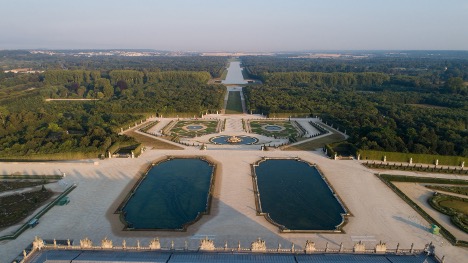
Photo Credit: ©Château de Versailles / T. Garnier
How many sculptures were ordered to embellish the water parterre at the foot of the castle?
The sculpted decor of the parterre d’Eau planned by Le Brun was expanded annually until it reached twenty-four marble statues, four groups of Abductions and a large arcade of rocks adorned with numerous figures. This arrangement was never completed and the already sculpted statues were instead distributed throughout the garden after the project was abandoned. Le Nôtre’s second parterre d’Eau also has twenty-four bronze sculptures or groups, which are much more sober in silhouette. A large, fairly flat fountain was also planned for the center of each of the basins, but these were abandoned during the course of the project.
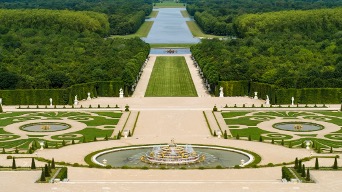
Photo Credit: ©Château de Versailles / T. Garnier
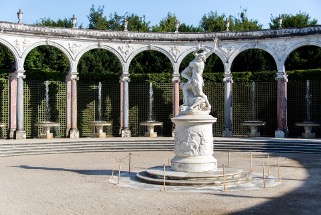
Photo Credit: ©Château de Versailles / T. Garnier
What types of trees are found in the landscaped groves?
Originally, the groves were carved out of a wooded area consisting mainly of oak trees. It soon became apparent that these trees, which were too tall and slow-growing, were likely to disrupt the layout of the rooms. The oaks were therefore gradually replaced by sycamore maples, which were not as tall. Inside the green rooms, the plantations were mainly topiaries of yew, laurel and hornbeam. It was only under Louis XVI that the new quinconces and the green circle grove were planted with lime and oak.
Header Photo Credit: Photo Credit: ©Château de Versailles / T. Garnier




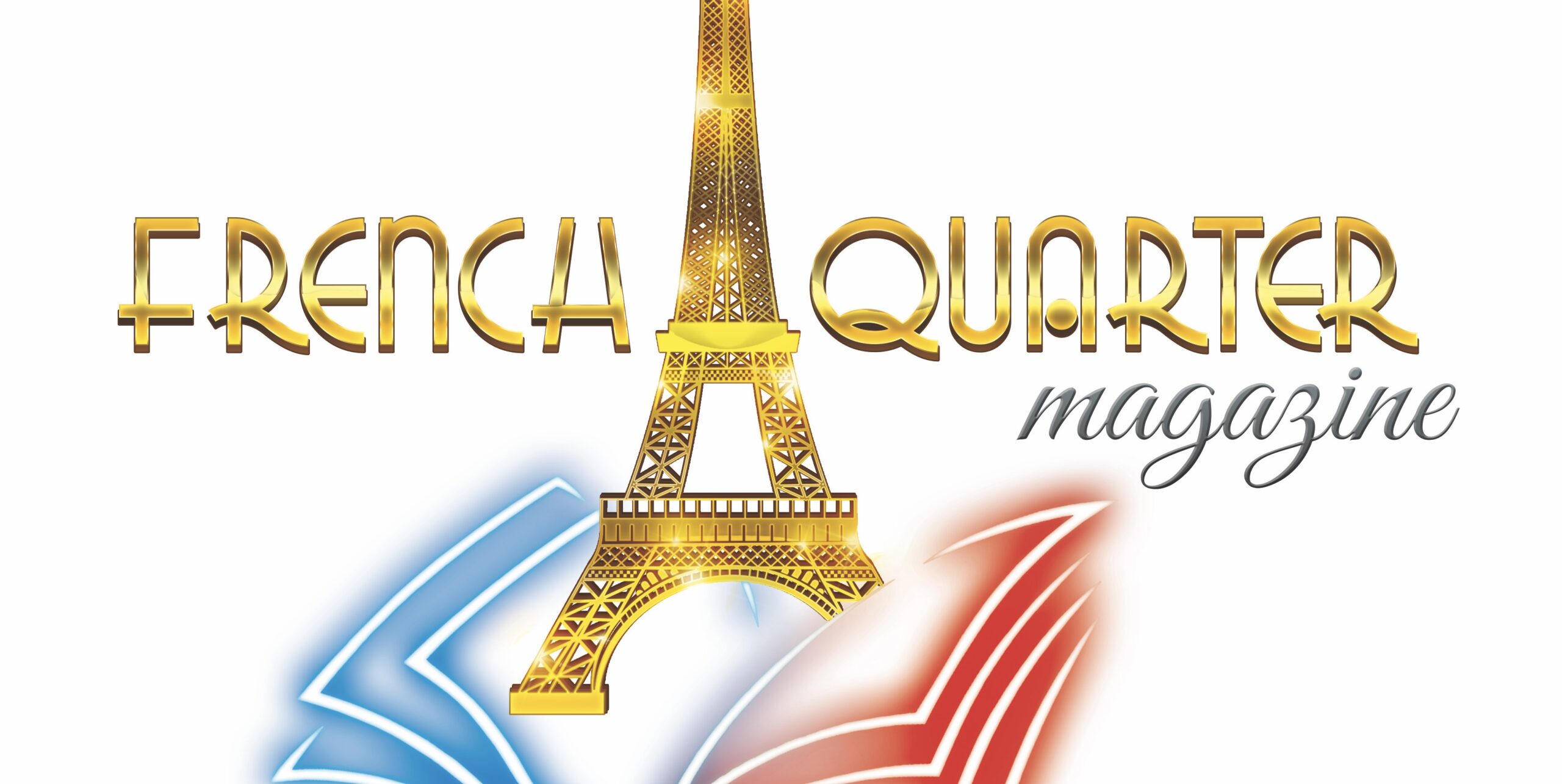




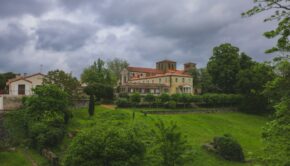







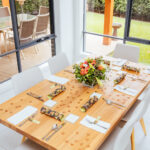


Fantastic read! This article does an excellent job of breaking down what smart homes are and how they’re transforming modern…